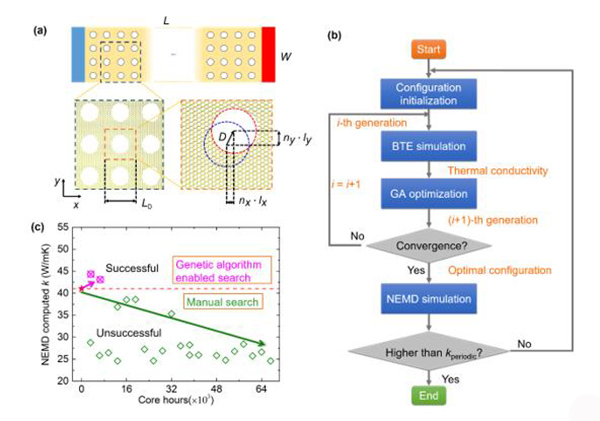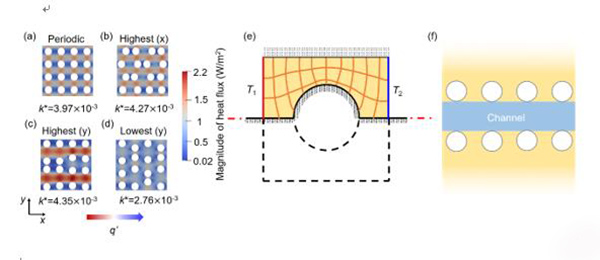Professor Hua Bao of the University of Michigan-Shanghai Jiao Tong University Joint Institute (UM-SJTU JI) and Professor Xiulin Ruan of Purdue University jointly published their latest research work on applying machine learning to uncover the new thermal transport mechanism in nanoporous graphene. The research paper entitled “Genetic algorithm-driven discovery of unexpected thermal conductivity enhancement by disorder” was published recently in “Nano Energy” , a high-level academic journal in the field of energy, covering original research studies in the field of energy in nanoscale. Han Wei, a JI doctoral student of the SJTU Zhiyuan Honor Program, is the first author. Professor Hua Bao and Professor Xiulin Ruan are co-corresponding authors.

(a) The schematic of nanoporous graphene. (b) The workflow of the “two-step” search process based on genetic algorithm. (c) A comparison of optimization output and the overall time cost between the genetic algorithm enabled search method and manual search method.
Manipulating thermal transport in nanostructured materials is of great significance for the heat dissipation in electronic devices, thermoelectric energy conversion, etc. Constructing nanoporous structures is an important way to tune the thermal conductivity of nanostructured materials. In addition to porosity, the arrangement of pores can also tune the thermal conductivity of the nanoporous structure. Previous research works have concluded that, compared with periodic pore arrangements, disordered pore arrangements can significantly reduce the thermal conductivity of porous structures. Because random pore arrangements can induce the localization of thermal transport, thus further impede thermal transport.
This research investigates the thermal transport in nanoporous graphene and aims to challenge the accepted knowledge by searching for exceptions with machine learning algorithms. A manual search is first shown to be expensive and unsuccessful. Numerical simulations of 21 disordered porous graphene configurations are performed with a high-performance computer, in which 67200 core hours are spent. For all 21 disordered configurations, the thermal conductivity values are considerably lower than that of the periodic structure. Such a result is consistent with the widely accepted knowledge that the disorder will reduce the thermal conductivity due to the thermal transport localization. In order to find exceptions more efficiently, the research group proposes a “two-step” search method based on genetic algorithm. Preliminary screening and optimization are performed through a less computational expensive Boltzmann transport equation model. Then the more accurate and computational expensive molecular dynamics simulation is implemented for validation. Through such a “two-step” search process, when only 6604 core hours are spent, the thermal conductivity enhancement is successfully discovered in certain structures with random pores.
 The exceptions discovered through the “two-step” genetic algorithm enabled search; The schematic of the shape factor and the heat conduction channel.
The exceptions discovered through the “two-step” genetic algorithm enabled search; The schematic of the shape factor and the heat conduction channel.
Through a comprehensive analysis of the structural characteristics of the discovered exceptions, it is found that the enhancement of thermal conductivity of these disordered structures results from the specific pore arrangement. Further study shows that the shape factor and the heat conduction channel have a more significant effect on the thermal conductivity of porous graphene than the localization effect. Further regression analysis shows that the shape factor and channel factor have strong correlations with thermal conductivity. Therefore, these two new physical parameters can be used to establish a machine learning surrogate model for a quick estimate of the thermal conductivity of nanoporous structures.
Machine learning algorithms are widely used in data mining, computer vision, natural language processing, biometric recognition, search engines, and medical diagnosis. In the field of engineering thermophysics and materials, machine learning algorithms can be used to perform regression and make prediction, but they have been rarely used to uncover new physical mechanisms. This study demonstrates a new research paradigm that is guided by machine learning to discover exceptions and further advance theoretical development.
The research work obtained financial support from Guangdong Province Key Area R&D Program (2019B010940001) and the National Natural Science Foundation of China (No. 51676121). SJTU’s Materials Genome Initiative Center and Center for High Performance Computing also provided help.
Biography
 Han Wei is a Ph. D. student at the University of Michigan-Shanghai Jiao Tong University Joint Institute. She obtained B.S. degree in Energy and Power Engineering from Huazhong University of Science and Technology, China, in 2017. She then joined JI and was selected into the “Shanghai Jiao Tong University Zhiyuan Honorary Doctoral Program”. Her current research interests are in machine learning and thermal transport in nanostructured materials.
Han Wei is a Ph. D. student at the University of Michigan-Shanghai Jiao Tong University Joint Institute. She obtained B.S. degree in Energy and Power Engineering from Huazhong University of Science and Technology, China, in 2017. She then joined JI and was selected into the “Shanghai Jiao Tong University Zhiyuan Honorary Doctoral Program”. Her current research interests are in machine learning and thermal transport in nanostructured materials.





